
|   |

|   |
My experience with the Navarasa Sadhana - Uma Katju e-mail: umakatju@gmail.com March 21, 2016 (Navarasa sadhana is the systematic and daily practice of the Nine Basic Emotions by the actors with the aim of strengthening their capacities for producing aesthetical experiences. Uma Katju was one of the 23 participants in the ‘Navarasa sadhana’ workshop conducted by Guru G. Venu at the Intercultural Theatre Institute in Singapore from 12th January to 11th March 2016. The other participants were from Singapore, Malaysia, Australia, Taiwan and France.) Our Kutiyattam training with Venuji began in early January. For two months we learnt the physical form and navarasa sadhana. The physical form included slokas, movement and mudra sequences. In the navarasa sadhana, Venuji systematically took us through the nine basic emotions – sringara (love with desire), adbhuta (wonder or astonishment), viram (heroic), raudram (anger), bhayanakam (fear), karunam and karuna (pathos or grief and compassion), hasya (humour), bibhatsa (disgust), santham (peace/detachment). 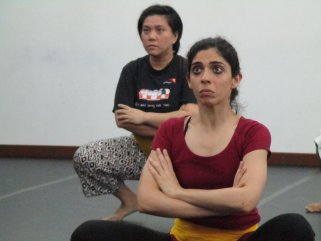 Regina Foo (Singapore) and Uma Katju (India) 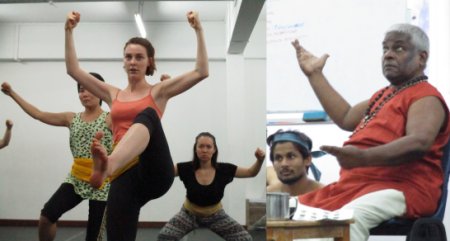 Guru G. Venu teaching the students 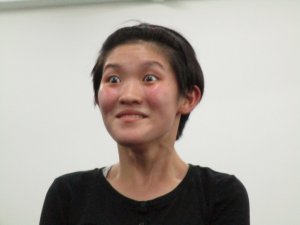 Hau Guei Sze (Malaysia) demonstrating a bhava 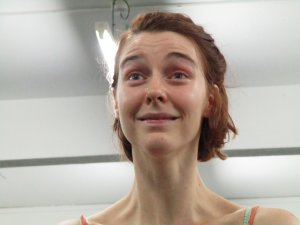 Gala Shevtsov (Australia) Each emotion was first experienced by us walking around the space, making sounds or singing songs, while imagining a situation we could associate with that emotion. After repeating this exercise a few times, Venuji taught us a simple walking pattern for each rasa. There was a specific walking pattern, posture and position in which to experience it. We imagined our associations in that posture as expansively and sensually as we could – sights, flavors, touch, smells, sounds and music. For me, the key to experiencing the bhava was the imagination. This was especially interesting as it is often believed that the traditional forms are essentially technical and involve strict learning of choreographies and set patterns. Instead, one day Venuji said not to worry so much about the walking and technicalities and rather concentrate on the experience. This helped me a great deal, as I had been worrying about the correct steps, movement and proper gestures. This requirement was perhaps more for the sessions with the physical form itself. In my experience, sometimes the smallest association, imagining the slightest of touches, a flavor or sight had a great effect and would make the experience of the bhava much longer. Each emotion had particular senses attached to them as well. For example, while in sringara all senses were aroused, in raudram we were to hear all the insults and diatribes of our enemies to provoke anger. I found that my imagination was more deeply stimulated by some emotions, sometimes unexpectedly so. For example, raudram, with the image of the lion roaring, was very evocative. On the other hand, hasyam, which I thought would be easier, was very difficult to achieve. The stronger the association and imagination, the stronger was the emotion. After we had practiced the first eight emotions, Venuji told us to look for characters we could associate with each specific rasa. They should be characters that represent the most extreme or heightened experience of the rasa. The concept was individual-actor-character, that is, from ourselves as people, we must enter the basic body of the actor, the subtle body, physically in the bending the knee position. Then reminding ourselves of the character and their situation in every tiny detail – for example, the time of day, the space, the weather, the colour of their clothes – we take the position of the character. And thus, begin experiencing the bhava. Uttering the phrase ‘Aa samayathinggal’ or ‘at that time’ to ourselves helps us to recall and enter the character. Venuji insisted it is important to make the transition from individual to actor to character, and to practice the navarasa as the character. The importance of this transition hit me most when we began training karunam or pathos, grief. Walking in the space, I imagined the most painful experience I had ever had, my dadi or paternal grandmother’s death. That was the first time I had just felt without judging my emotions. As I walked in the space, I began to cry softly, but as I heard the others in the group crying, I began to sob too. Our sobs slowly turned to howling. But as I cried I realized that I had started to feel very hysterical and while I wanted to stop the emotion, it wouldn’t go away. Partly my grief, and partly a rejection of it and almost hysteria towards it were driving the tears. I was very aware that I was becoming more and more hysterical. Finally, Venuji asked us all to lie down and relax, and the crying dissipated. As I was in the middle of the hysteria, I began to question why we were doing this in the first place. I felt like the exercise would drive me mad and if this is how it were to be, I didn’t want to do any more navarasa training. I recalled the criticisms of Stanislavski’s method of emotional recall, that actors sometimes were unable to stop their emotions once they were in the body. Venuji later explained the difference – in the Kutiyattam training, recalling these experiences was strictly part of the training and not to be taken on stage. Then the usefulness and importance of transformation from individual to actor to character became clearer to me. Entering the emotion through the character would help me to distance myself from it, and also help me imagine different and extreme experiences outside of my own. I feel that the strong characters that I found for the navarasa practice helped me enter the emotions more deeply, than the ones where my associations or characters were weaker.  Desmond Soh (Singapore) demonstrating the lotus flower 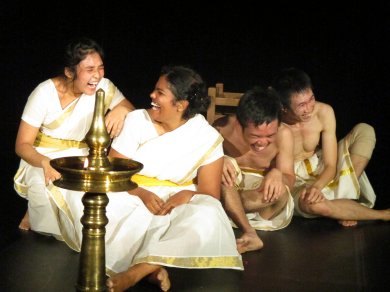 A moment in invoking hasya rasa The imagination and the body combined being the actor’s toolkit, is what I found through the navarasa training. In each emotion, my physicality and breath became activated in very different ways. I discovered that even breathing deeply can be of many different kinds. To experience the final emotion, santham, Venuji asked us to work on improvisations of some of the transitory emotions, for example, poverty, severe illness, punishment. The improvisation was not intended as a performance for an audience, rather to really experience that emotion. The transitory emotions being quite outside of my experience, I decided to place my body in concrete situations that could possibly approximate some of these states. For instance, for me poverty is deprivation, and I could deprive myself of food. So I chose one school day to not eat. While aware that a day’s fast is nowhere near a state of hunger and starvation, I felt from my small experience I could imagine how that may feel. The particular day I fasted, we also had the maximum physical classes in school, so I imagined going through a day’s physical labour while hungry. This experience of improvisations has been very useful, as I understood how my body responded to different stimulations. It has also given me a sense of how to go about similar experiments to put my body in situations in which I can experience different emotions. After completing the navarasa sadhana training, I feel like it was a dream. Something I was completely immersed in, very tangible and real, and now has disappeared! The rasas, the Natyasastra says, are like fire, and the actor’s body dry firewood. Once consumed by bhava, it is reduced to ash. This now seems a description of my whole experience of the Kutiyattam training. |